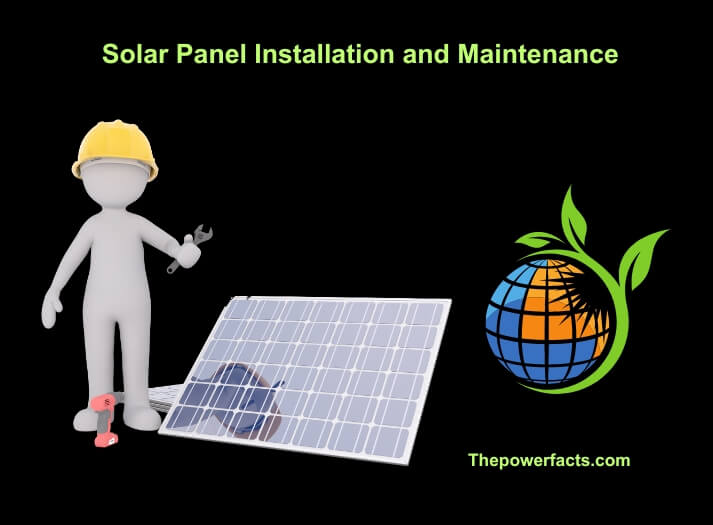So, you’ve made the decision to tap into the sun’s infinite power and reduce your carbon footprint. That’s fantastic! Solar panel installation and maintenance might seem like a daunting task, but fear not! This comprehensive guide will shed some light on the entire process. We’ll cover everything from choosing the right solar panel system for your needs to ensuring optimal performance and a long lifespan for your shiny new panels. Let’s dive right in, shall we?

Prepping for Solar Panel Installation
Choosing the Right Solar Panel System
Before you can bask in the glory of solar energy, you’ll need to pick the perfect solar panel system for your home or business. Keep the following factors in mind:
- Type of Solar Panels: Monocrystalline, polycrystalline, and thin-film panels each have their pros and cons. Do your homework!
- Energy Consumption: Estimate your energy needs based on your electricity bill, and choose a system that can meet or exceed those requirements.
- Budget: You get what you pay for, but don’t break the bank! Shop around for a system that balances quality and affordability.
Roof Inspection and Site Assessment
Before you can slap those solar panels onto your roof, you’ll want to make sure it’s up to snuff. A roof inspection and site assessment will help you determine:
- Roof condition: Can your roof support the added weight of solar panels? Are there any repairs needed?
- Roof orientation and angle: Does your roof face the sun? Is the angle suitable for maximum sunlight absorption?
- Shading: Are there trees or other structures casting shadows on your roof? You might need to trim some branches or relocate some panels.
Solar Panel Installation
Hiring a Professional Installer
When it comes to solar panel installation, it’s best to leave it to the pros. A professional installer will have the necessary skills, tools, and experience to ensure a smooth and safe installation process. Look for certified and reputable installers in your area.
Installation Process and Timeline
Solar panel installation isn’t a walk in the park. Expect the following steps:
- Obtaining permits and approvals
- Installing the mounting system and wiring
- Placing the solar panels and connecting them to the inverter
- Final inspection and system activation
The entire process can take anywhere from a few weeks to a few months, so patience is a virtue!
Solar Panel Maintenance and Troubleshooting
Routine Maintenance for Optimal Performance
Solar panel maintenance is a piece of cake! Just follow these simple tips:
- Keep ’em clean: Dust, dirt, and bird droppings can reduce your panels’ efficiency. Give them a good scrub every now and then.
- Monitor performance: Keep an eye on your solar energy production to spot any potential issues.
- Schedule annual inspections: A professional inspection can help catch problems early and ensure your system is running smoothly.
Troubleshooting Common Solar Panel Issues
Solar panel systems are pretty reliable, but every now and then, you might run into a hiccup. Here are some common issues and how to address them:
- Reduced energy production: If your system isn’t producing as much energy as it should, check for shading, dirty panels, or loose connections.
- Inverter issues: If your inverter is displaying an error message or not functioning properly, consult the user manual or contact the manufacturer for assistance.
- Damaged panels: Cracks or discoloration on your panels may indicate damage. Consult a professional for repair or replacement options.
Maximizing Your Solar Investment
Taking Advantage of Incentives and Rebates
Don’t leave money on the table! Research local, state, and federal incentives and rebates that can help offset the cost of your solar panel installation and maintenance. These programs can include tax credits, grants, or utility rebates.
Net Metering and Selling Excess Energy
With net metering, you can earn credits for any excess energy your solar panels produce. These credits can be used to offset your electricity bill, and in some cases, you can even sell the excess energy back to the grid for a profit!
FAQs
How long do solar panels last?
Most solar panels have a lifespan of 25-30 years, with a gradual decline in efficiency over time.
How much do solar panels cost?
The cost of solar panels can vary widely based on the type, size, and quality of the system. On average, a residential solar system can range from $15,000 to $25,000 before incentives and rebates.
Can I install solar panels on a flat roof?
Absolutely! Solar panels can be installed on flat roofs using specialized mounting systems that allow for optimal angle and orientation.
Do solar panels work in cloudy weather?
Solar panels can still generate electricity in cloudy weather, although their efficiency may be reduced. Even on a cloudy day, your solar panels can produce 10-25% of their rated capacity.
Is solar energy storage necessary?
While not required, energy storage systems like solar batteries can store excess energy generated by your solar panels for use during power outages or at night.
Last Point
Embracing solar panel installation and maintenance is a brilliant way to harness the sun’s power, reduce your carbon footprint, and save on energy costs. By choosing the right system, hiring a professional installer, and keeping up with routine maintenance, you’ll be well on your way to a more sustainable and eco-friendly future. Don’t forget to take advantage of incentives and rebates, as well as net metering, to maximize your solar investment. Happy sun-catching!